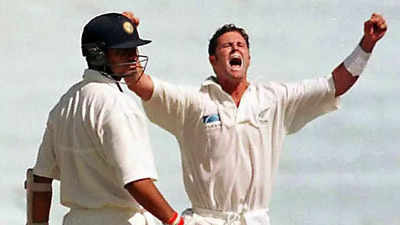
NEW DELHI: The Test cricket rivalry between India and New Zealand is one marked by mutual respect, with both teams often bringing their unique strengths to the fore.
Historically, India has had an upper hand overall, especially in home conditions, but New Zealand has been a tough competitor, particularly on their own soil.
The Kiwis, under the captaincy of Stephen Fleming, toured India for a three-Test series in October 1999.
The first Test was in Mohali and it ended in a draw. Seldom does a drawn Test leave a lasting impression on the minds of fans. But this one does.
The Test had a delayed start because of a damp pitch and when the then Indian captain Sachin Tendulkar lost the toss, Fleming had no hesitation in asking India to bat first.
Dion Nash took 6/27 as the Kiwis used only three pacers and yet only three Indian batsmen reached double figures.
India were bundled out for just 83 runs in 27 overs in their first innings.
A rattled India pulled up their socks quickly and pace spearhead Javagal Srinath took 6/45 as New Zealand were bowled out for 215 runs in their first innings.
Indian openers Devang Gandhi and Sadagoppan Ramesh wiped out the first innings deficit with a 137-run stand and then the imperious batting pair of Rahul Dravid and Sachin Tendulkar dug in to build on the innings.
Dravid (144) and Tendulkar (126*) put on a partnership of 229 runs for the third wicket.
Sourav Ganguly smashed an unbeaten 64 off 75 balls as India declared their second innings at 505/3 to set New Zealand a stiff 374-run target.
Fleming then led from the front and in a fine display of resolute Test match batting, played a determined 73-run knock to save the Test for his side, as the Kiwis ended their second innings at 251/7 despite the Indians trying their very best to get all 10 wickets.
Dion Nash’s spell of 6/27 is one of the standout performances in New Zealand cricket history as he produced a remarkable spell of swing and seam bowling, completely dismantling India’s batting line-up.
Playing in India is always a challenge for overseas teams, particularly because of the spin-friendly nature of the pitches. However, in Mohali, seamers can sometimes find assistance due to the early morning moisture and cooler temperatures.
Nash’s 6/27 remains one of the finest bowling performances by a New Zealand fast bowler in Indian conditions, where seam bowlers usually have to work hard for their wickets.
The performance is often remembered for how Nash extracted movement and exploited the conditions, something not many seamers manage to do consistently in India.
This spell remains one of Nash’s most memorable moments in international cricket and is a significant part of New Zealand’s Test cricket history.
